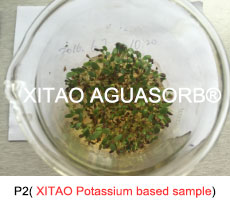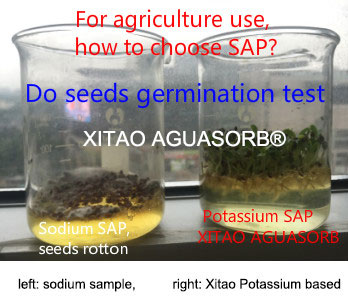
XITAO AGUASORB® potassium based super absorbent polymer is functional polymer, it can absorb hundred times of its own weight of water in a short time, and can absorb & release repeatedly.
Why SAP is popular in seeds coating now?
As we know, there are three conditions needed for seeds to be germinated
-Iight
-temperature
-moisture
In seeds coating technology, SAP can improve two of them: water and temperature.
And it also provide some advantages such as nutrients, protection against fungal diseases, or insecticidal treatments.
Seed Coating SAP
This is a new functional polymer which can absorb and keep moisture needed for seeds germination.
This water gel can always keep seeds damp and give a unwavering temperature status, also the seeds coating polymer formulation enables seeds to be coated evenly, which makes it easier to work with on farm and promotes a more even seed distribution in the paddock. In addition, the lime helps to optimise the pH level immediately around the germinating seed, which promotes faster moisture uptake by the seed and better establishment.
Advantages
-Keep seeds damp and give a unwavering temperature status
-Nutrients designed to be immediately available to the seedling
-Protection against fungal diseases through a fungicide treatment;
-Insecticidal treatments to provide protection form biting and sucking insects.
Dosage
Seed coating use SAP should be fine particle size of 200mesh, after SAP coating the seed emergence quickly, strong and good disease resistance, this is the easy available way using SAP to plants in drought area, which is also with small quantity, low cost and good performance.
In agriculture and horticulture, a seed treatment or seed dressing is a chemical, typically antimicrobial or fungicidal, with which seeds are treated (or "dressed") prior to planting. Less frequently insecticides are added. Seed treatments can be an environmentally more friendly way of using pesticides as the amounts used can be very small. It is usual to add color to make treated seed less attractive to birds if spilt and easier to see and clean up in the case of an accidental spillage.
One seed treatment, imidacloprid, from the neonicotinoid family of insecticides, is controversial and was banned in France for use on maize, due to that government's belief that the chemical was implicated in recent dramatic drops in bee counts, and possibly in Colony Collapse Disorder.[1] Dust from treated seed is known to have caused at least some problems particularly from crops such as maize drilled during the main honey flows. Improvements to pneumatic drills to reduce dust release, and improvements to seed treatment compounds to prevent the compound breaking up into dust have been introduced in Europe led by Germany and the Netherlands from 2009 to 2012. Information on seed treatments including the information above can be seen on the registration authority databases.
Seed coating is a thicker form of covering of seed and may contain fertilizer, growth promoters and or seed treatment as well as an inert carrier and a polymer outer shell.
Seed dressing is also used to refer to the process of removing chaff, weed seeds and straw from a seed stock. Care is needed not to confuse the two.
Why choose potassium based SAP (KSAP)?
For agriculture use, please pay much attention to those sodium based SAP for disposal use, which is sodium polyacrylate product and degrade very fastly,as per the chemicals structure.

2)Identify the quality
Although both are co-polymers, but it exists potassium and sodium based types, sodium based is much cheaper than potassium based and it can rotten the plant roots and caused soil cake. Potassium based is for agriculture use only, it’s good for plant growth. Also, the cross-linking agent is different during polymerization, the less cross-linked typed with high absorbency rate, but with worse release performance and weak gel strength. Also the raw material purity and ratio & polymerization technology are essential for the product quality.
3)Identify the supplier
Fully check manufacturer’s production technology, raw material purity, solid content etc, ask samples to do the compared testing.
4)Do grass seeds germination test
To check SAP product is potassium based or not, the simple way is to do the grass seeds germination test, steps as belows:
1) measure 1g SAP sample, put it into 110g tap water within 10minutes it will be hydrated to water gel.
2) measure 1g grass seeds, put them on the surface of the water gel.
3) after 4-7 days, the seeds put on the potassium based SAP gel will be germinated.
do the same with the compared sample.
Sodium based sample ( P1) degrades faster, and no seeds germinated, seeds get rotten.


you can see the difference of sodium based sample VS XITAO potassium based sample (P2), regarding sodium sample, there is no seeds germinated, XITAO samples have good germination rate.

It's the way that XITAO lab to check if SAP is potassium based SAP or not, FYI.
ATTN: SAP shall be applied in the soil, can’t be used as soil-less cultivation.
Application method
I. Dry method: mix SAP with fine soil, throw even into the planting furrow or planting cave, after sowing or planting, watering thoroughly, then covered with soil.
II. Wet method:make SAP to 120-130 times hydrogel. (i.e, mix 1G SAP with 120-130 ml water), then apply into the planting trench, mix even with ditch soil,then sow the seeds in planting trench, water after casing to guarantee SAP in water stored state.
TIPS
● SAP shall be applied at the root.
● Don't expose SAP in the air, as the O2 in the air can make the SAP degraded.
● SAP can't make water, it is effective as drought-resistance agent only in the case of a small amount of water.
● If in dry method, watering thoroughly. If without watering condition, wet method is suggested.
● No matter in dry or wet application, SAP must be mixed evenly with ditch subsoil to avoid water excessive concentration.
● Due to the difference of regional soil, climate and drought conditions, application shall be based on the actual situation.

Xitao Polymer Co. Ltd.
Tel:+86-10-60491602
Fax:+86-10-60492072
Email: